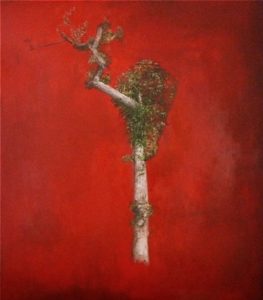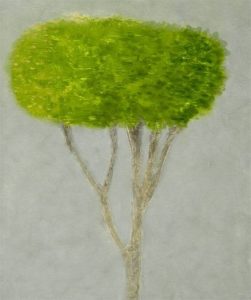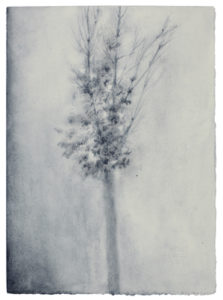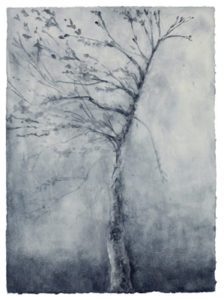
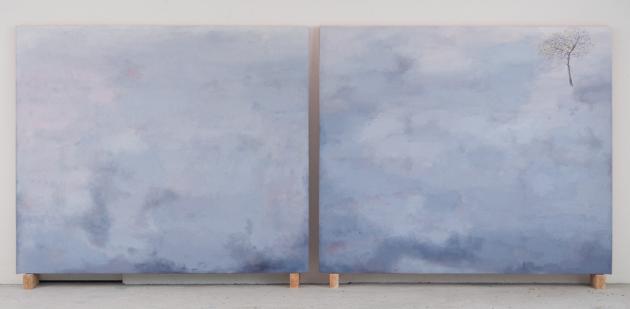
Lucas Reiner, Interview
Lucas REINER – Interview
Lucas REINER – Interview
Lucas Reiner, a painter, engraver and photographer, gave this interview for CatenArt. Since 2001, Lucas Reiner has focused on what he calls the « portrait » of curbside trees in his hometown, exploring the formal collision between organic growth and the constraints of modern urban life.
He is the one who will guide the next Residency in Gdanzk to explore the theme of freedom, its dynamism and its questioning of the ability to choose and engage.
Trees are the most important subject of your work. Can you tell us what they mean to you, and what it is you love about them?
Trees are rooted in the earth and grow to reach the heavens. As an idea, for me, trees represent a perfect connection of the earth and the heavens, the seen and unseen worlds. I am primarily interested in the infinite variety of forms that trees embody as a result of being shaped by time and by their environments. By looking in a naïve and unknowing way, I see the unique forms and qualities of each individual tree as something new, something that I’ve never seen before; a phenomenon waiting to be discovered or revealed. I see in their growth a metaphor for the human condition and our struggle to make peace with our environment and our destiny. I’m also fascinated with the countless ways that trees have been interpreted and used for so many origin stories, sacred writings and mythologies, signifying such a rich tapestry of ideas.
While walking through the woods in Michigan in 2001, I came upon an area of the forest that had been ‘clearcut’ and harvested by the paper company that owned the land. While walking through what had been a large area of mature Birch trees that was now reduced to acres of trunks, I became aware that underfoot I was walking on thousands of tiny trees the size of blades of grass that were beginning to grow. I was overcome with a feeling of time passing, creation and destruction, and how an organic, infinitely renewable resource can keep growing, in spite of the violence that it is subjected to.
Could you tell us a bit about your own roots, as a man, and as a painter?
On my father’s side of the family, my grandfather came from the Austro-Hungarian town of Czernowitz, (Chernivitsi) and my Grandmother was from Bucharest. On my mother’s side, my grandmother was from Warsaw, and grandfather from Königsburg. My mother and my father were born in New York city in the early part of the 20th century. I was born in Los Angeles. If geography is destiny, I am an American child of European history, a European soul in an American body.
My mother, Estelle Reiner, was a painter and through her I was introduced to the work of so many great European painters; Matisse, Braque, Picasso, Bonnard, Beckman, Morandi, as well as the American post-war painters that she loved: Pollock, Kline, Rothko, Alice Neel, Mark Tobey, Twombly and more.
Both my mother and I studied painting with a wonderful painter named Martin Lubner. I was fortunate to be exposed to the work of these painters in such a thoughtful way. The paintings were brought to life for me by the were passion that Marty was able to convey about the qualities that made the work so unique.
What do you think of the Catena Artistorum project?
Catena Aristorum Project is a great way for artists to come together, share discoveries and exchange inspirations and ideas. The pursuit of artists, like all of life, is so interconnected, but in a very specific way. As society becomes more and more mechanistic, it is important for artists to know that they are not alone in their pursuits. I’m honored to be invited and look forward to participating in the Gdánsk meeting.
What is, in your own experience, the relationship between art and freedom?
Art and freedom are both only possible in their ongoing relationship and negotiation with constraint.
I think of freedom as the engine that allows artists to travel further into new, unchartered and unknown areas; constructing a kind of a bridge to lead people into new sensations and insights.
There are some beautiful lines by Stravinsky about freedom in art that I would like to include in the meeting at Catena Gdánsk:
“My freedom thus consists in my moving about within the narrow frame that I have assigned myself for each one of my undertakings. I shall go even further: my freedom will be so much the greater and more meaningful the more narrowly I limit my field of action and the more I surround myself with obstacles. Whatever diminishes constraint, diminishes strength. The more constraints one imposes, the more one frees one’s self of the chains that shackle the spirit.”
What message do you have for young artists ?
Stay connected to other artists and the history of art. This might help you realize that you are part of something much larger than yourself. Stay curious. Read, draw, write, look, learn. Art for the artist is a lifetime of work, and finding something that will sustain you is like a baby taking its first step. Be aware and watchful for the things that excite and inspire and speak to you. You don’t have to have a “big idea”, but you do need inspiration, and it can come from anywhere and anything at any time. Stay open to what is around you. Inspirations often appear as something slight or small, and can be easily ignored. Allow them in. Write it down, give it a voice, expose it, bring it into the light of day.
Don’t let your fears or your desire for your work to turn out perfectly inhibit you. Sometimes the imperfections, accidents and mistakes are the very thing that will make your work unique, or allow you to reach a new place.
Lucas Reiner
Los Angeles, 2020

